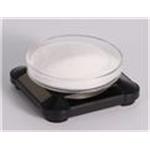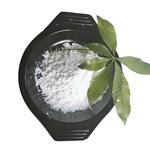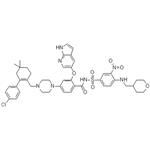
ABT-199
- Product NameABT-199
- CAS1257044-40-8
- MFC45H50ClN7O7S
- MW868.44
- EINECS820-130-9
- MOL File1257044-40-8.mol
Chemical Properties
| Melting point | >150°C (dec.) |
| Density | 1.340±0.06 g/cm3(Predicted) |
| storage temp. | -20°C Freezer |
| solubility | DMSO (Slightly) |
| form | Yellow solid. |
| pka | 4.09±0.10(Predicted) |
| color | Light Yellow to Yellow |
| InChIKey | LQBVNQSMGBZMKD-UHFFFAOYSA-N |
| SMILES | C(NS(C1=CC=C(NCC2CCOCC2)C([N+]([O-])=O)=C1)(=O)=O)(=O)C1=CC=C(N2CCN(CC3CCC(C)(C)CC=3C3=CC=C(Cl)C=C3)CC2)C=C1OC1=CN=C2NC=CC2=C1 |
Usage And Synthesis
Venetoclax(1257044-40-8) is a first-in-class, oral, selective BCL-2 inhibitor (BH3-only mimetic). The drug is approved in numerous countries, including those of the EU and in the USA, for the treatment of adults with relapsed or refractory (RR) CLL. The drug arose from research by Abbott Laboratories (now AbbVie) during a collaboration with Genentech and is being codeveloped by AbbVie and Genentech/Roche primarily.
Venetoclax(1257044-40-8) has high affinity for BCL-2, binding to the protein with an affinity more than three orders of magnitude greater than to BCL-XL or BCL-W in vitro. By binding to BCL-2, the drug displaces BCL-2-bound proapoptotic proteins (such as BIM), resulting in the permeabilization of mitochondrial outer membranes, activation of caspases, and restoration of cancer cell apoptosis, with this process requiring the apoptosis regulators BAX or BAK.
Chapter 10 - Bcl-2 Inhibitors as Sensitizing Agents for Cancer Chemotherapy
Venetoclax displayed cytotoxic activity in various tumour samples/cell lines, including some derived from CLLs, various other NHL subtypes, acute lymphoblastic leukaemias (ALLs), AMLs, chronic myeloid leukaemias (CMLs) and MMs. Notably, the sensitivity of venetoclax correlated with higher BCL-2 expression, with a BCL-2 high status [i.e. BCL-2 gains, BCL-2 amplifications, or the t translocation, which is a notable cause of deregulated BCL-2 expression] and higher BCL-2/MCL-1 ratios being potentially predictive of sensitivity to the drug.
Vogler, M, et al. "ABT-199 selectively inhibits BCL2 but not BCL2L1 and efficiently induces apoptosis of chronic lymphocytic leukaemic cells but not platelets." British Journal of Haematology 163.1(2013):139-42.
Vaillant, François, et al. "Targeting BCL-2 with the BH3 Mimetic ABT-199 in Estrogen Receptor-Positive Breast Cancer." Cancer Cell 24.1(2013):120-9.
Lindeman, G. J., et al. "Abstract P2-09-01: Targeting BCL-2 with the BH3 mimetic ABT-199 in ER-positive breast cancer." Cancer Research 73.24 Supplement (2013):P2-09-01-P2-09-01.
Treatment of chronic lymphocytic leukaemia
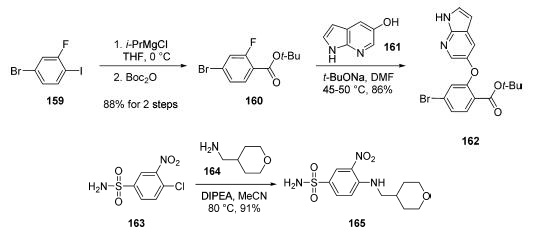
Synthesis of the third venetoclax subunit, piperazine amine hydrochloride salt 172, began with commercial cyclohexanone 166. Vilsmeier-Haack formylation of the sterically more accessible enol tautomer of 166 delivered vinyl chloride 167 in quantitative yield. Coupling of this chloride with commercial aryl boronate 168 gave rise to transient enal 169 in 87% assay yield, which was not isolated. Crude 169 was then carried into a reductive amination reaction with commercial N-Boc piperazine (170). Precipitation and recrystallization from acetonitrile ultimately furnished piperazinyl alkene 171 in 74% yield from 167. Finally, subunit 172 was obtained via Boc removal with concentrated HCl in IPA at 65 ??C and subsequent filtration, conditions that provided a 95% yield of high purity intermediate 172 (>99.5%).
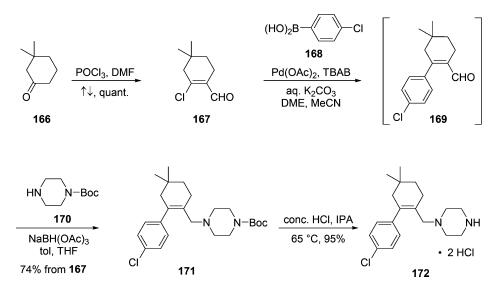
The final approach to venetoclax involved a palladiumcatalyzed coupling of amine 172 with aryl bromide 162, ester hydrolysis, and coupling of the resulting carboxylic acid with sulfonamide 165. In practice, Buchwald-Hartwig amination of 162 with 172 proceeded smoothly and relied upon workup with cysteine to enable cleansing of residual palladium from the reaction mixture. This reaction gave rise to advanced intermediate 173 in 89% yield after crystallization from cyclohexane. Treatment of 173 with t- BuOK/H2O/2-MeTHF at 55 ??C provided the corresponding free acid, which was immediately activated with EDC/DMAP/ Et3N to promote coupling with sulfonamide 165 at room temperature. The final drug target could be accessed by crystallization from EtOAc and washing with 1:1 DCM/EtOAc, yielding venetoclax (XVIII) in free base form in 71% over the two final steps. This synthetic route was capable of fashioning the drug target in 52% overall yield based on the longest linear sequence (7 steps).
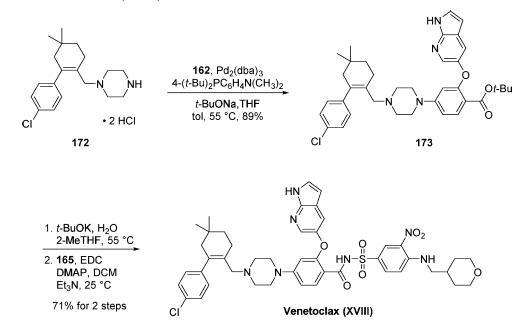
Antibacterials: concentration possibly increased by ciprofloxacin, clarithromycin and erythromycin - reduce venetoclax dose; avoid with rifampicin.
Anticoagulants: avoid with dabigatran; concentration of warfarin increased.
Antidepressants: avoid with St John’s wort.
Antiepileptics: concentration possibly reduced by carbamazepine, fosphenytoin and phenytoin - avoid.
Antifungals: concentration possibly increased by fluconazole, itraconazole, ketoconazole, posaconazole and voriconazole - reduce venetoclax dose.
Antipsychotics: increased risk of agranulocytosis with clozapine - avoid.
Antivirals: concentration possibly reduced by efavirenz and etravirine - avoid; concentration possibly increased by ritonavir - reduce venetoclax dose.
Bosentan: concentration of venetoclax possibly reduced by bosentan - avoid.
Calcium channel blockers: concentration possibly increased by diltiazem and verapamil - reduce venetoclax dose.
Cardiac glycosides: avoid with digoxin.
Cytotoxics: avoid with everolimus.
Grapefruit juice: avoid concomitant use.
Modafinil: concentration of venetoclax possibly reduced - avoid.
Sirolimus: avoid concomitant use.
Vaccines: avoid with live vaccines.
Excretion is mainly by the faecal route (>99.9
%; 20.8
% unchanged).
Preparation Products And Raw materials
ABT-199 manufacturers
Related articles
Related Product Information
- 2-[(1H-Pyrrolo[2,3-b]pyridin-5-yl)oxy]-4-[4-[[2-(4-chlorophenyl)-4,4-dimethylcyclohex-1-enyl]methyl]piperazin-1-yl]benzoic acid
- 1-((4'-chloro-5,5-dimethyl-3,4,5,6-tetrahydro-[1,1'-biphenyl]-2-yl)methyl)piperazine
- 1H-Pyrrolo[2,3-b]pyridin-5-ol, 1-[tris(1-methylethyl)silyl]-
- Methyl 4-Fluoro-2-{1H-pyrrolo[2,3-b]pyridin-5-yloxy}benzoate
- 3-nitro-4-((tetrahydro-2H-pyran-4-yl)MethylaMino)benzenesulfonaMide
1of4
The What'sApp is temporarily not supported in mainland China
